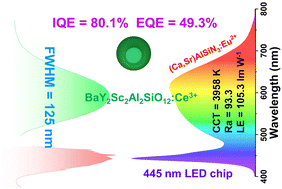Exploring high-efficiency broadband green phosphors that match the eye's natural perception to produce light-emitting diodes (LEDs) with vivid color reproduction and exceptional saturated colors is highly desired. Herein, bright green luminescence is revealed in an all-inorganic single-phase Ce3+-activated broadband garnet-type BaY2Sc2Al2SiO12 (BYSASO:Ce3+) phosphor. Under 439 nm InGaN-based blue LED chip irradiation, the representative BYSASO:3%Ce3+ sample shows a suitable green emission with the maximum emission peak position located at 532 nm and an impressive full width at half-maximum (FWHM) of 125 nm, which can cover more cyan gap without sacrificing the green components. High internal quantum efficiency (IQE = 80.1%), outstanding thermal resistance behavior (73.9%@423 K) and color stability, and appropriate CIE color coordinates of (0.3700, 0.5394) make this excellent optical material suitable for industrial application. Finally, a prototype warm white LED device is obtained with the proposed green-emitting BYSASO:3%Ce3+ phosphor and a commercial red-emitting (Ca,Sr)AlSiN3:Eu2+ phosphor upon blue chip excitation, exhibiting extraordinary optical properties with a satisfactory Ra of 93.3 and comfortable CCT of 3958 K, as well as an excellent luminous efficacy of 105.3 lm W−1. The results indicate that the green-emitting BYSASO:Ce3+ garnet phosphor has remarkable potential to serve as a conversion material for high-quality illumination.
